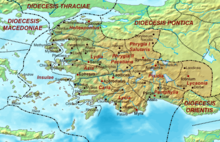
Cynopolis was the Hellenistic toponym for two cities in ancient Egypt. Both Cynopolis superior and Cynopolis inferior were bishoprics in Christian times.

Tripolis on the Meander – also Neapolis, Apollonia, and Antoniopolis – was an ancient city on the borders of Phrygia, Caria and Lydia, on the northern bank of the upper course of the Maeander, and on the road leading from Sardes by Philadelphia to Laodicea ad Lycum. It was situated 20 km to the northwest of Hierapolis.
Titiopolis or Titioupolis was a town of ancient Cilicia and later in the Roman province of Isauria.
Bisanthe was a great city in ancient Thrace, on the coast of the Propontis, which had been founded by the Samians. About 400 BCE, Bisanthe belonged to the kingdom of the Thracian prince Seuthes II. At a later period its name was changed into Raedestum, Rhaedestum or Rhaideston (Ῥαίδεστον), or Raedestus, Rhaedestus or Rhaidestos (Ῥαίδεστος); but when this change took place is unknown. In the 6th century CE, the emperor Justinian did much to restore the city, which seems to have fallen into decay; but after that time it was twice destroyed by the Bulgarians, first in 813, and a second time in 1206. The further history of this city, which was of great importance to Byzantium, was covered by Byzantine historians George Pachymeres and Cantacuzenus. It is generally believed that the town of Resistos or Resisto, mentioned by Pliny the Elder, and in the Antonine Itinerary, is the same as Bisanthe; but Pliny mentions Bisanthe and Resistos as distinct towns. Coins minted by Bisanthe survive. Under the name Rhaedestus, it remains a titular see of the Roman Catholic Church.
Amyzon in Caria was an ancient city 30 km south of modern Koçarlı.
Aureliopolis in Lydia is a city in the Roman province of Lydia, previously called Tmolus or in Greek Τμῶλος (Tmolos). It issued coinage under each of these names, and one coin combines both names. In the Synecdemus it appears as Auliou Kome. The name "Aureliopolis" was given in honour of the emperor Marcus Aurelius.

Mesarfelta was a Roman–Berber town in the province of Numidia. It was also a bishopric that is included in the Catholic Church's list of titular sees.
Zenopolis was an ancient Roman and Byzantine city and episcopal see variously placed in Lycia or in neighbouring Pamphylia.
Daldis, was a town on the borders of ancient Lydia and Phrygia, a former bishopric, and is now a Latin Catholic titular see. It also minted coins in antiquity with the legend Δαλδιανων. It also bore the name Flaviocaesaria or Phlabiokaisareia, which is not attested among ancient authors but is reconstructed from epigraphic and other evidence.
Hierapolis in Isauria was a city and diocese in ancient Isauria, which remains a Latin Catholic titular see. Its modern site seems unclear.
Theodosiopolis (in Arcadia) was an Ancient city and diocese in Lower Egypt,

Beneventum was an ancient city and bishopric in Tunisia. It is now a Latin Catholic titular see.

Satala or Satala in Lydia was a Roman era city and Bishopric in ancient Lydia.
Acrassus or Akrassos was an ancient Roman and Byzantine-era city in Lydia. in the Roman province of Asia and Lydia. Apparently, it is the same place that Ptolemy calls Nacrasa or Nakrasa, placed on the road from Thyatira to Pergamum.

Tabala, was a Roman and Byzantine town and a Bishopric in ancient Lydia. Tabala was on the Hermus River, and minted its own coins. It was probably mentioned by Hierocles under the name of Gabala, which is perhaps only miswritten for Tabala. It is even possible that it may be the town of Tabae or Tabai (Τάβαι), which Stephanus of Byzantium assigns to Lydia.

Aptuca (Africa) or Henchir Oudeka, also known as Aptucca/Aptuca, Henchir-Oudeka/Henchir-Semmech. or Udeka is a village and archaeological site in Tunisia, North Africa located at 36.409344, 8.940301.
Drusiliana was a civitas (town) of Roman North Africa. Bingham called it a city of the Roman province of Mauretania Caesariensis. An inscription of Constantine the Great was found in the city ruins and it appears on the Tabula Peutingeriana The town has been tentatively identified with ruins near Khanguet-el-Kdim in northern Tunisia. Located at 36.249547°N 8.907667°E. Epigraphical evidence suggest Constantine the Great undertook some works in the city in 312AD.

Foratiana was an ancient Roman-Berber city in the province of Byzacena and Africa Proconsularis in the Sahel region of Tunisia.

Edistiana was an ancient Roman–Berber city in the province of Africa Proconsularis and in late antiquity of Byzacena. It was located in the modern Tunisia. It was a former Catholic diocese.

Cinna or Kinna was a town of ancient Galatia. It was known as Zallara in the Hittite period. It was also the seat of a bishop; no longer a residential see, it remains a titular see of the Roman Catholic Church.








